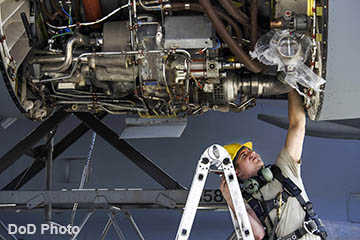 Faced with budget cuts and a shortage of spare parts, military forces often resort to the inefficient maintenance practice of cannibalization – a strategy in which serviceable parts are removed from one complex asset to satisfy the operational needs of another higher-priority asset.
Faced with budget cuts and a shortage of spare parts, military forces often resort to the inefficient maintenance practice of cannibalization – a strategy in which serviceable parts are removed from one complex asset to satisfy the operational needs of another higher-priority asset.
Although discouraged, cannibalization has long been a routine practice for military Maintenance, Repair and Overhaul (MRO) organizations. It is particularly widespread for aircraft maintenance, as units work to maintain readiness on aging fleets at a time of increased deployments.
Cannibalization is usually practiced whenever it’s faster to harvest a component from existing equipment than it is to order the part from the supply system. Once this action is complete, an order is created to replace the component taken from the donor asset.
Drawbacks to Cannibalization
Although cannibalization may be beneficial on a very limited and controlled basis, the practice of systemic cannibalization actually decreases readiness, and increases maintenance and supply chain costs.

A heavily cannibalized A7 Corsair on display at the Russel Military Museum in Illinois.
By executing cannibalization, units are increasing their maintenance requirements, risking additional maintenance downtime due to incorrect fault identification and/or faulty repairs, and creating added supply chain turbulence. Furthermore, cannibalization can actually reduce the life of components.
However, an integrated maintenance and supply solution like GOLDesp MRO & Supply addresses these challenges. Developed by Tapestry Solutions, a Boeing Company, GOLDesp provides total lifecycle support for complex assets operating in land, air, sea and space environments.
GOLDesp ensures total asset visibility, giving operators a heightened awareness of the whereabouts, condition and availability of all components. With a click of a button, operators can determine whether an asset is on a shelf in a warehouse, installed on an end item, or is midstream through the repair cycle. This allows users to quickly assess alternatives to cannibalization.
Why Cannibalization Increases Costs & Risk
By providing superior tracking and automated workflow of all activities, GOLDesp reduces the risks and costs associated with cannibalization. It also limits unnecessary cannibalization activities and improves operational readiness of equipment. Here’s how:
- Cannibalization Increases Maintenance Workloads
It increases workloads by effectively doubling the amount of MRO work necessary, compared to simply installing a delivered part. The asset takes twice as long to repair and additional quality inspection is required for the removed part. This significantly increases personnel labor hours and costs.
quality inspection is required for the removed part. This significantly increases personnel labor hours and costs. - Cannibalization Renders Expensive Assets Unusable Temporarily
The donor equipment’s airworthiness and/or availability is reduced following cannibalization, affecting the donor assets’ future mission readiness. Failure to track the exact components removed can result in safety and/or financial issues due to inoperable equipment. - Cannibalization Can Result in Mechanical Side Effects
The physical act of removing components from complex assets is also problematic. In executing the removal and replacement, technicians may damage the components or connected systems. For example, removing fuel lines within engines to access fuel regulators or pumps may result in damage to the fuel system, increasing future maintenance costs and down time.
Systemic cannibalization is a symptom of poor maintenance management, lack of supply and maintenance integration, inadequate scheduled maintenance practices and the faulty quality assurance/control.
How GOLDesp Limits Cannibalization Risks

When cannibalization is absolutely necessary, GOLDesp limits risks through automated workflow, inventory management, total asset visibility and supply chain integration. The commercial-off-the-shelf software provides superior recordkeeping and tracking for all cannibalization activities in the following ways:
- GOLDesp tracks all cannibalization activities and assets impacted to determine if cannibalization is appropriate. If so, the cannibalization action can only be performed after a part request has been created, and it has been determined that no items are available in supply inventory. A work order is then created, documenting the process and capturing required sign-offs.
- GOLDesp ensures cannibalization is controlled and traceable. Approval authority for cannibalization is an important management step for an exchange. Authority to cannibalize assets is controlled by role-based security and approvals, which require electronic certification (E-Cert) signatures. The need for sign-off authorization, and the level of authorization required, can be determined for each GOLDesp customer site.
- GOLDesp streamlines processes, including the creation and linking of records and work orders. This includes enabling access to past and current cannibalization records. Thus, all actions are traceable, reducing delays during future MRO of the donor equipment.
- GOLDesp provides automated notifications of back-orders. If a replacement part becomes back-ordered, GOLDesp will immediately notify maintenance control personnel, who in turn, can then set the status of the equipment to “Not Mission Capable-Supply,” or NMCS, and make a determination on whether or not to cannibalize the part.
- GOLDesp provides quality assurance/quality control process flows, ensuring that all testing and quality assurance/quality control is integrated as part of the repair process. Inspections are required and must be completed through use of authorized signatures by qualified, certified personnel.
This applies to processes ranging from flight certification to scheduled and unscheduled maintenance to component repair. GOLDesp guides the required process flows and ensures that the right people are engaged at the right time to achieve the best readiness outcomes.
Material Forecasting and DoD Supply Chain Integration
GOLDesp’s material forecasting capabilities ensures spares are readily available to support maintenance activities. This minimizes the need for cannibalization by accurately identifying requirements for new parts in advance, while reducing stockpiling of unnecessary spares.
GOLDesp’s material forecasting module examines past consumption in order to forecast future consumption and stock levels. It automatically correlates past consumption with completed maintenance/repair work orders over a specific period, supporting minimum and maximum ordering requirements. GOLDesp also:
- Manages scheduled maintenance, reserves parts required directly from work orders and automatically replenishes stocks based on usage and demand forecasting
- Automatically alerts maintenance managers to scheduled inspections and repairs
- Provides a fleet level view of equipment readiness that allows operational and maintenance managers to make the right resource allocation decisions at the right time
- Seamlessly interfaces with the U.S. military’s supply system. The software automates key processes that allow users to order material from the U.S. Department of Defense via Foreign Military Sales’ MILSTRIP processes. This includes automatic generation of military (MILS) requisitions, cancellations and amended messages.
Mission Accomplished with GOLDesp
In summary, GOLDesp ensures mission readiness by eliminating and/or mitigating cannibalization practices, thereby ensuring maximum equipment availability – whenever, wherever assets are needed. Above all, GOLDesp gives maintenance officers confidence in their logistics system and business practices by providing the right data needed to make the right decisions, and maximizing their resources to accomplish their missions.
The appearance of U.S. Department of Defense (DoD) visual information
does not imply or constitute DoD endorsement.
Contact:
Janet Dayton
Tapestry Solutions Inc.
tapestrymarketing@boeing.com
Watch videos to learn more about GOLDesp.



